Intel SSD 520 Review: Cherryville Brings Reliability to SandForce
by Anand Lal Shimpi on February 6, 2012 11:00 AM ESTRandom Read/Write Speed
The four corners of SSD performance are as follows: random read, random write, sequential read and sequential write speed. Random accesses are generally small in size, while sequential accesses tend to be larger and thus we have the four Iometer tests we use in all of our reviews.
Our first test writes 4KB in a completely random pattern over an 8GB space of the drive to simulate the sort of random access that you'd see on an OS drive (even this is more stressful than a normal desktop user would see). I perform three concurrent IOs and run the test for 3 minutes. The results reported are in average MB/s over the entire time. We use both standard pseudo randomly generated data for each write as well as fully random data to show you both the maximum and minimum performance offered by SandForce based drives in these tests. The average performance of SF drives will likely be somewhere in between the two values for each drive you see in the graphs. For an understanding of why this matters, read our original SandForce article.
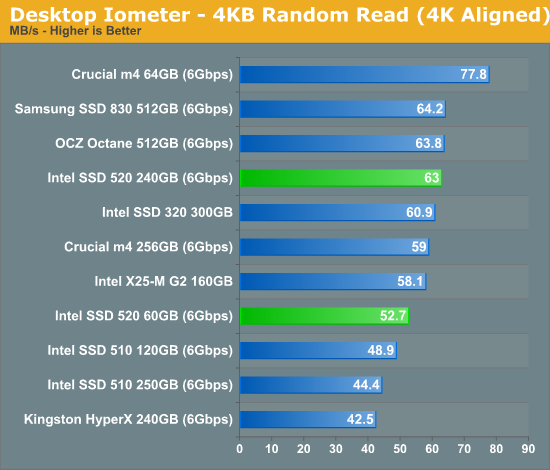
Random read performance seems to have topped out around 60MB/s for most drives and the 520 is no different here.
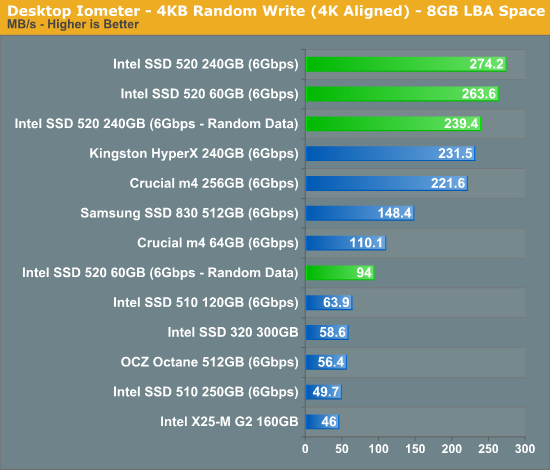
Random write performance, especially with highly compressible data sets the 520 performs beautifully - even outpacing the SF-2281 based Kingston HyperX.
Many of you have asked for random write performance at higher queue depths. What I have below is our 4KB random write test performed at a queue depth of 32 instead of 3. While the vast majority of desktop usage models experience queue depths of 0 - 5, higher depths are possible in heavy I/O (and multi-user) workloads:
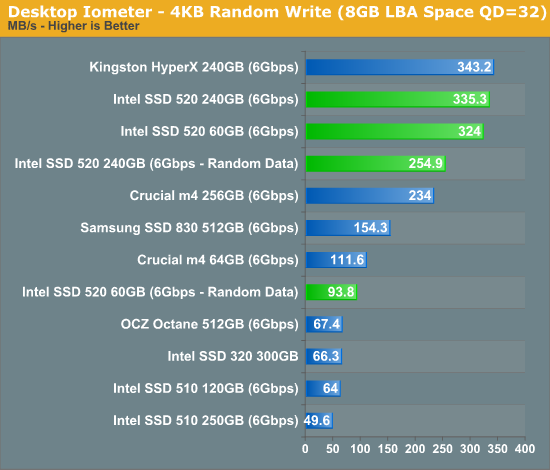
At higher queue depths the HyperX catches up to and surpassed the 520, perhaps indicating that Intel has done some work to optimize low queue depth performance on the 520 (likely what most end users will encounter).
Sequential Read/Write Speed
To measure sequential performance I ran a 1 minute long 128KB sequential test over the entire span of the drive at a queue depth of 1. The results reported are in average MB/s over the entire test length.
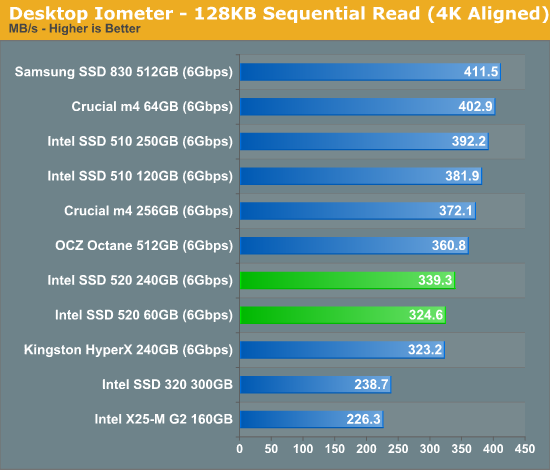
Sequential read performance is actually a bit lower than Intel's 510, but still higher than a standard SF-2281 drive.
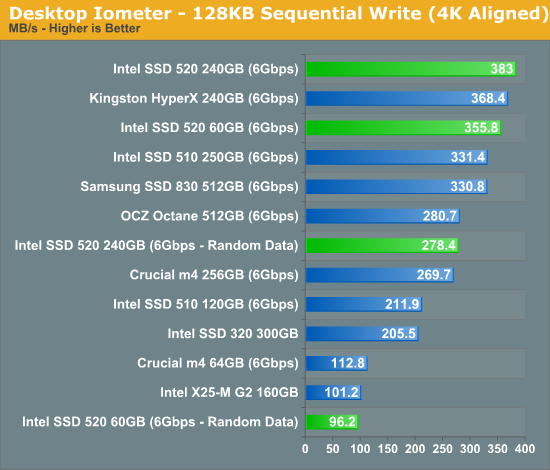
It's important to note just how close the 520's peak random write performance is to its sequential write performance. A big part of this is obviously that the SF-2281 is throwing away a lot of the data it has to write, but even if we compare incompressible 4KB random write to highly compressible 128KB sequential write we see a good ratio. The closer those two values are the more optimal the controller/firmware design is as, in theory, smaller random writes should be grouped to effectively become large sequential writes from the perspective of the NAND.










138 Comments
View All Comments
GrizzledYoungMan - Monday, February 6, 2012 - link
Excellent review, Anand. I really appreciate your focus on reliability/compatibility over performance in your latest SSD reviews; that really reflects my own experience in terms of where SSDs need to improve.Do you (or anyone) know when the Intel 520 is scheduled to be available for sale? I didn't notice this information in your article.
Here's hoping it's soon. I am returning a newly purchased Crucial m4 (which has a number of rather absurd semi-known/unacknowledged issues, like stuttering with Intel RST drivers installed, and failing to wake up from sleep) and seeking to replace it with an Intel drive. After owning OCZ and Crucial, I am really looking forward to not having to extensively modify my system just to get things working.
GrizzledYoungMan - Monday, February 6, 2012 - link
This just came up on Amazon: http://www.amazon.com/Intel-SSDSC2CW120A3K5-2-5-In...Price looks right, and is sold by Amazon directly. Can anyone confirm that this model number is correct?
ckryan - Monday, February 6, 2012 - link
Cherryville has been selling in small quantities for weeks now. Benches and pics have been out there. I thoroughly enjoy every one of Anand's SSD reviews as it's never just a review of the drive, but in this case the 520's performance profile has been established well in advance of NDA expiration.Intel's reliability is well deserved IMHO. For those of us wishing against hope for Intel's 10 channel 6gbps controller, keep hoping. As late as 60 days ago, I was hoping that the 520 would utilize the Marvell controller, but when Cherryville started shipping a few weeks back, all hope was lost. And it was pretty obvious when the specs were leaked months and months ago.
Intel's own controller is not fast by the standards of today, but Intel really got to the heart of the matter with the first and second gen drives, which is speed is superfluous without reliability.
SandForce drives have been tamed to a large extent with the 3.3.2FW, but I'm unconvinced of their long term reliability -- the nDurance chart literature reproduced in the article is not realistic in any way, and in my experience SF drives tend to lose in endurance compared to it's competitors. I still own and use SF drives, but when I need reliability over speed, SF is not the way I personally choose to go.
I respect Intel's decision to go SF, and in it's entirely likely that no drive has received the internal scrutiny that the 520 has -- and I'm sure it will pay dividends. But I won't be selling my older Intel drives on eBay anytime soon.
GrizzledYoungMan - Monday, February 6, 2012 - link
Good comment, and useful thoughts, thank you.Since you seem to have a lot of experience with these devices, and similar priorities as me, which would you pick for the system disk of a workstation: the 320 or the 520, both at 120GB? I'm on a p55 mobo with a 3gb/s SATA controller, FYI.
While the performance of the 520 series is attractive, I'm still inclined to believe that I wouldn't notice the real world difference between the two. In which case the 320 series wins on demonstrated reliability.
ckryan - Monday, February 6, 2012 - link
The 320 has a great record -- it's one reliability fault was the rare 8MB error, since corrected. Firmware is so crucial with SSDs, and the actual act of updating FW can cause issues of it's own (ala the Samsung 830, another excellent drive).On a 3gbps Intel mobo port you won't get the sequential speeds, but you will get the good random performance and the 520 handily bests it's fore-bearers in that area.
So I suppose that the issue of price should be considered. The 120GB 320 and 520 are going to be nearly the same price -- so you'd be getting more with the 520. I would say if you're comfortable with it, get the 520.
Regardless of whether SSD or HDD, you should be in a position that if the drive dies 20 minutes from now, restoring your data to it shouldn't be a problem. With that in mind, you can probably bet that the 520 will hold out for it's 5 year warranty. If it doesn't, you still have a 5 year warranty.
As an aside, I recently bought a 320 series 120GB just to have on hand should the need arise, and it is pretty magnificent. I think most people would be just as happy with a 320 than a faster 520 -- the people who crave speed are going to get the fastest drive anyway, so for everybody else the 320 series is still a viable option.
Roland00Address - Monday, February 6, 2012 - link
The 80gb intel 320 has routinely been on sale for the last month from several different online retailers. The sales involve mail in rebates but you see final MIR prices being between 70 to 90 dollars for the 80gb.The 120gb intel 320 on the other hand hasn't really gone on sale in Janurary, only time it went on sale in the last few months was a black friday sale (and BF is not a normal thing.)
GrizzledYoungMan - Tuesday, February 7, 2012 - link
Just bought a 120gb Intel 320 series SSD for $182.00 - nearly $1.50 a gig. Not bad.Between the reliability (both in terms of software, architecture, and power loss protection) and the insane IO performance on reads at lower queue depths, I feel confident I made the right choice.
alpha754293 - Monday, February 6, 2012 - link
Reading this, I'm tempted to buy the 180 GB version because I will be using it in a HPC environment.And if the OCZ Vertex 3 is going to have BSOD issues, I'd rather pay a little bit of a premium or lose a little in storage capacity in order to make sure that the system will be humming along perfectly/nicely.
Such a shame/waste that the Vertex 3s are relegated to being just data drives.
neotiger - Monday, February 6, 2012 - link
It doesn't look like Intel 520 has any capacitors to prevent data loss.So how is this SSD any different from the 5,000 other SandForce SSD's already in the market, except this one is much more expensive than the others?
Sunrise089 - Monday, February 6, 2012 - link
Read the article ;)